The Road: Ride on the Abandoned Pennsylvania Turnpike, May 2009
Pennsylvania has more land preserved in parks and forests than any other state aside from California and Alaska. But it also has an enormous number of abandoned structures: homes, mills, blast furnaces, bridges, railway stations and buildings and tracks.... you name it, and its probably lying empty and useless between the Delaware River and the Ohio border. The ranks of the abandoned include many roads, and none more historically significant than the world's first superhighway.
Lets take a trip back in time. For most of the past two centuries if you were to draw a picture to represent the population centers in the Commonwealth, you would draw a barbell, not a keystone. One stack of weights is Philadelphia; the other is Pittsburgh. The bar represents the 300 some mile distance between the cities. However, a weightlifting bar is straight. A straight line between Philadelphia and Pittsburgh means crossing mountains and major rivers. The state capitol, Harrisburg, is located two-thirds of the distance between Pittsburgh and Philadelphia, and someone driving in the 1930s would have taken six hours to complete the trip from the capitol to the Steel City. Motorists both recreational and commercial wanted a faster, safer way to travel. So in 1938 plans were made to construct a state of the art superhighway between Harrisburg and Pittsburgh, with the idea the road would eventually be expanded to cross the state. On October 1, 1940, the 160 mile roadway opened, and cut travel time from six to two and a half hours.
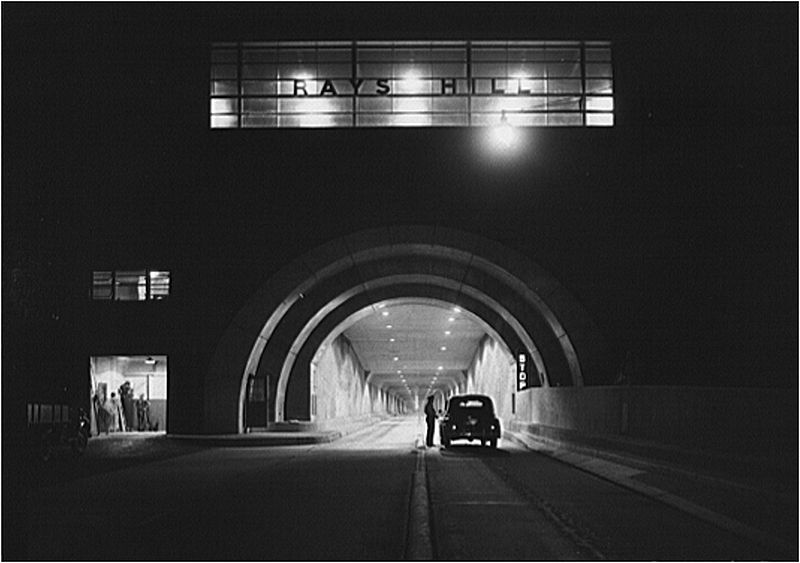 The new roadway used much of an old route. In the 1880s construction took place on the South Pennsylvania Rail Road, but the line went bankrupt and left behind seven tunnels through the mountains. Fifty years later these tunnels were refurbished and used for the Turnpike. The photo, from Wikipedia Commons, shows Ray's Hill Tunnel on a night in 1942.
The new roadway used much of an old route. In the 1880s construction took place on the South Pennsylvania Rail Road, but the line went bankrupt and left behind seven tunnels through the mountains. Fifty years later these tunnels were refurbished and used for the Turnpike. The photo, from Wikipedia Commons, shows Ray's Hill Tunnel on a night in 1942.
Skipping ahead to the 1960s, the Turnpike is a financial and engineering success, and now reaches across the Commonwealth. Success brings problems. The Turnpike Commission decides to expand the road to four lanes to reduce congestion and begins constructing new tunnels and bypassing others. Ray's Hill, along with Sideling Hill Tunnel and the roadway between them, are bypassed in 1968.
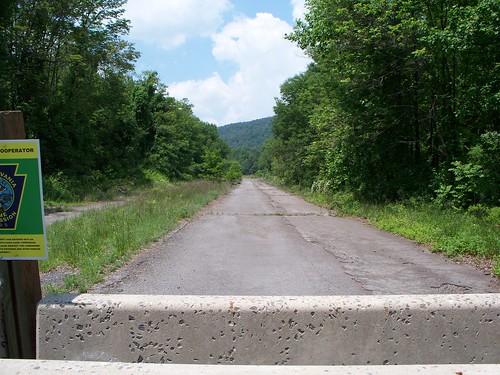 When cyclists and hikers began exploring the abandoned road is unknown. But it probably wasn't long after the bypass was opened. The Turnpike Commission bowed to the public and sold eight and a half miles of the old roadway, the stretch from Somerset to Breezewood including the two tunnels, to the Southern Pennsylvania Conservancy for a dollar in 2001. Ever since there have been attempts to get together the financing to open the "Pike to Bike" trail to the public. Officially the road is closed, and people ride and hike at their own risk. The surface hasn't been paved in five decades, and while the tunnels are considered structurally sound, they are unlit and damp. Sideling Hill is over a mile long; Ray's Hill isn't much shorter.
When cyclists and hikers began exploring the abandoned road is unknown. But it probably wasn't long after the bypass was opened. The Turnpike Commission bowed to the public and sold eight and a half miles of the old roadway, the stretch from Somerset to Breezewood including the two tunnels, to the Southern Pennsylvania Conservancy for a dollar in 2001. Ever since there have been attempts to get together the financing to open the "Pike to Bike" trail to the public. Officially the road is closed, and people ride and hike at their own risk. The surface hasn't been paved in five decades, and while the tunnels are considered structurally sound, they are unlit and damp. Sideling Hill is over a mile long; Ray's Hill isn't much shorter. 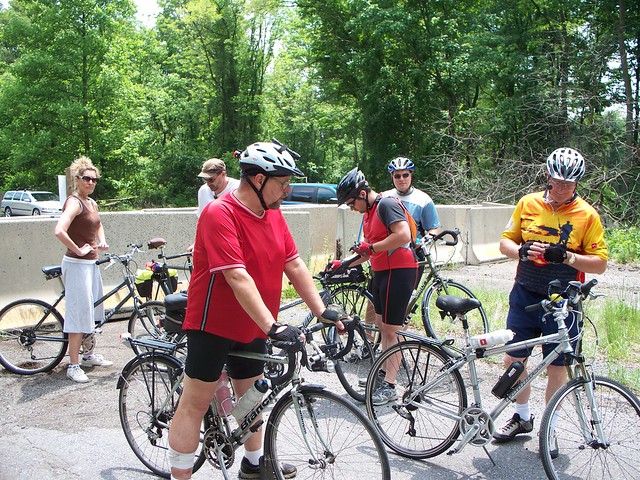 In May 2009 a group of riders who posted to Bikeforums.net traveled to the abandoned superhighway to ride. Parking was a nightmare requiring finding an overgrown limited access road. But once parked, the cyclists assembled. Most of the vehicles were mountain bikes, hybrids, and comfort bikes. One woman brought a trike. Everyone brought lights. I brought every light I owned. I was prepared.
In May 2009 a group of riders who posted to Bikeforums.net traveled to the abandoned superhighway to ride. Parking was a nightmare requiring finding an overgrown limited access road. But once parked, the cyclists assembled. Most of the vehicles were mountain bikes, hybrids, and comfort bikes. One woman brought a trike. Everyone brought lights. I brought every light I owned. I was prepared. 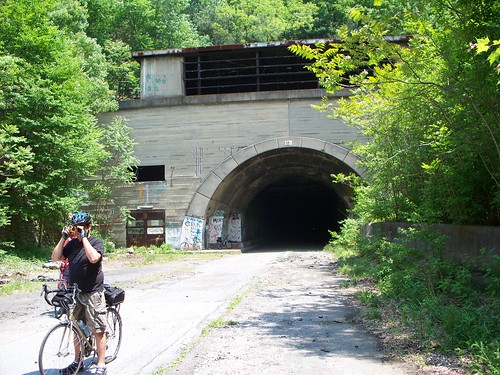 First tunnel up was Sideling Hill. Once I got used to the darkness and the chill I had little difficulty with the ride. My main concern was the slight upgrade through the middle of the tunnel - the grade at some points on the ride was 3 per cent - and the broken concrete I had to roll over. I had to dodge large chunks at some places. Ditto with Ray's Hill. The ride became creepier when someone in the group began whistling the theme from The Good, The Bad, and The Ugly in this near-perfect echo chamber.
First tunnel up was Sideling Hill. Once I got used to the darkness and the chill I had little difficulty with the ride. My main concern was the slight upgrade through the middle of the tunnel - the grade at some points on the ride was 3 per cent - and the broken concrete I had to roll over. I had to dodge large chunks at some places. Ditto with Ray's Hill. The ride became creepier when someone in the group began whistling the theme from The Good, The Bad, and The Ugly in this near-perfect echo chamber. 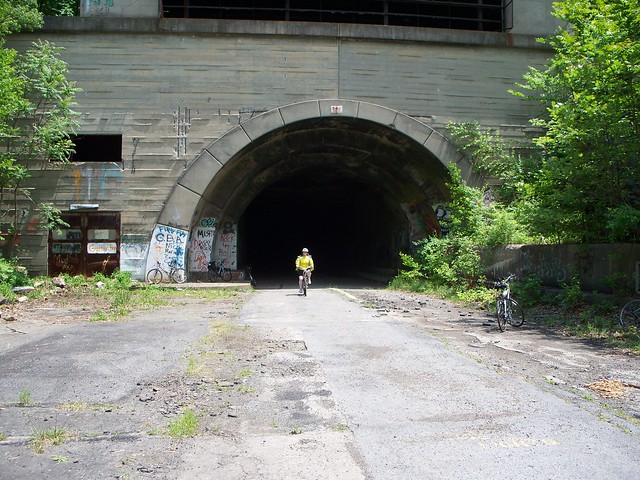 Our ride took place a half-year after the production company shooting The Road, a film of Cormac' McCarthy's dystopian novel, had used the Abandoned Turnpike and Sideling Hill Tunnel. In the film the director brought out the bleakness of the early Pennsylvania winter to show a world without hope, but we rode in the late Pennsylvania spring, and lushness was around us. It made a contrast to the crumbling, graffiti covered tunnels. We stopped at times to explore the service areas of the tunnels, and the land around. Or we just enjoyed the views. One never notices the scenery at 65 MPH. At ten to twelve one can do just that.
Our ride took place a half-year after the production company shooting The Road, a film of Cormac' McCarthy's dystopian novel, had used the Abandoned Turnpike and Sideling Hill Tunnel. In the film the director brought out the bleakness of the early Pennsylvania winter to show a world without hope, but we rode in the late Pennsylvania spring, and lushness was around us. It made a contrast to the crumbling, graffiti covered tunnels. We stopped at times to explore the service areas of the tunnels, and the land around. Or we just enjoyed the views. One never notices the scenery at 65 MPH. At ten to twelve one can do just that. 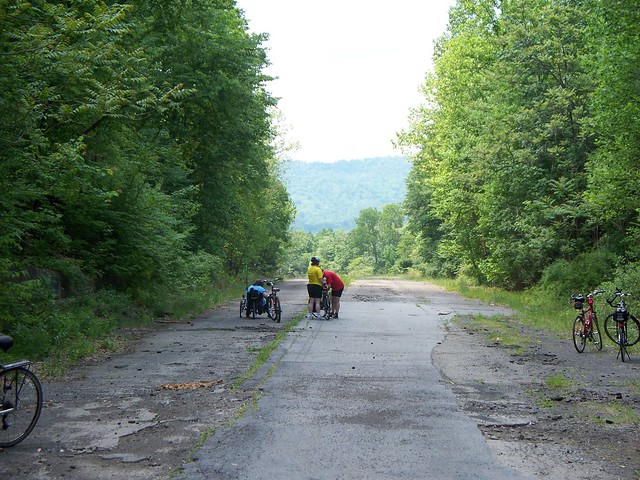 Soon enough we neared the end at Somerset, and turned around. Back through the tunnels, back to the cars. We left the road behind, but we have memories of a great time, and the desire to go back. I hope to ride the Abandoned Pennsylvania Turnpike again this year.
Soon enough we neared the end at Somerset, and turned around. Back through the tunnels, back to the cars. We left the road behind, but we have memories of a great time, and the desire to go back. I hope to ride the Abandoned Pennsylvania Turnpike again this year. Labels: Bicycling
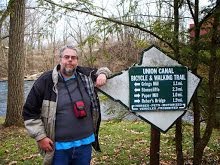

3 Comments:
This sounds terrific. I have to come and ride it as well some day.
Sorry to jump on your Blog. Neil are you still riding the MS150? Do you know if plans are going forward for a room in Cherry Hill and rooms in Ocean City?
I apologize if this is out of line.
Bill
Bill, yes, I am riding. And we are getting rooms both places. Send me a valid email address via the Team Clydesdale group at the MS City to Shore site and we can talk. I don't have a valid email for you.
Post a Comment
Note: Only a member of this blog may post a comment.
Subscribe to Post Comments [Atom]
<< Home